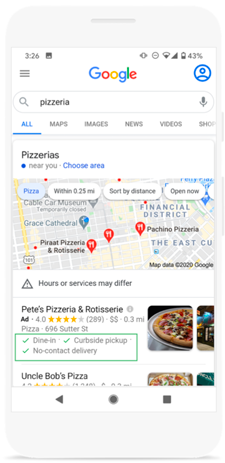Google is rolling out ad products geared to local businesses struggling to adapt to new customer behaviors that have developed since the world went screwy in mid-March.
It’s become a theme of the pandemic: the biggest of big tech platforms releasing advertising and commerce tools aimed at the smallest of small advertisers.
“We recognize the role that digital tools have played as a lifeline to many businesses and consumers,” said Jason Spero, Google’s VP of performance media. “[And] automation can help you dynamically respond to rapid changes in the market.”
Investing in automation
First, Google will soon add in-store sales measurement to smart bidding, which is Google’s suite of automated bidding solutions that use machine learning to optimize bids based on specific conversion KPIs.
Smart bidding for store visits will automatically account for variations in online conversions and store visits and adjust bids accordingly for every ad auction. This will help retailers get more specific with their targeting.
Rather than just optimizing for store sales, for example, retailers will be able to optimize for people who are likely to transact in store and at a certain basket size by uploading first-party sales data.
“We allow marketers to have more accurate ROI to calculate,” Spero said. “Otherwise, a conversion for a $5 transaction or the largest transaction look the same.”
Going local
In the same vein, Google is adding functionality showing online shoppers when and where they’ll be able to pick up a specific item if what they’re looking for isn’t in stock at that particular moment.
“The demand is moving around so much, and we are trying to put digital transformation in reach so that more people can take advantage of dynamic tools to adapt, react and drive better results,” Spero said. “This meets the moment of how people want to engage with the world around them right now.”
Businesses will also soon be able to augment local campaigns across search, Google Maps, YouTube and display with information that’ll appear on Google search and business profile pages, such as whether establishments offer indoor dining, takeout, curbside pickup, in-store shopping and/or no-contact delivery.
Google launched curbside pickup for local inventory ads in May so people can see what’s in stock at certain locations near them.
Behavior changes
Google’s product road map is drawing on new consumer behaviors. Search, YouTube and Maps activity shows that people are being more careful about planning store visits, Spero said. They want to know when a location is busy or to get confirmation that the product they’re looking for will be available when they get there.
“This is how consumers expect businesses to evolve and innovate,” Spero said.
In The Netherlands, for example, searches for “contactless payments” (in Dutch, of course) are up 225% year over year. In Germany, searches for store operating hours increased 175% YoY. And in the United Kingdom, online search interest in plants and gardening has gone up 10x on an annual basis as people try to make their decrepit apartments livable (or perhaps I’m just speaking for myself).
“There are new ROI opportunities for marketing versus eight or nine months ago,” Spero said, “[and] opportunities for marketers using these efficiencies to drive recovery and, ultimately, drive their business.”















